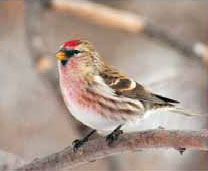Field Notes: Volunteering: It could change your life

Photo by Nick Saunders
The wind had been blowing all morning, piling up the dry snow in small drifts. I recall taking off my day pack and crouching over a thermos of soup with my back against a tree at the edge of a field. It was mid-morning, December 27, 1969, and although chilled, I was excited to participate in my first Christmas Bird Count. I had volunteered to rise before dawn and to head out in the blustery weather to collect observations on winter birds just north of Pittsburgh.
Soon, I heard the high chirps and twitters of a flock of small birds descending from the wind to alight on dried brown stalks of low plants in front of me. I scanned them with my 10 X 50 binoculars and I was experienced enough at the time to pick out the several American goldfinches even in their winter plumage, but there was another type of finch in the flock that puzzled me. I pulled out my Peterson’s bird field guide and studied it again. They were the same size as the goldfinches, but had a mix of light brown and white streaking, a black chin mark, and a distinct rosy-red forehead. Some also exhibited a pinkish wash on their breasts. What was this bird? As the dozens of small birds fed on weed seeds I soon came to the conclusion: common redpoll. The ones with the pinkish breasts were the males.
When I got back to the bird count reporting station to share my findings I learned just how unusual my observation was, and the compiler’s skepticism required that I take others back to the field for verification. The common redpoll rarely occurs so far south, especially in the numbers that I had witnessed. And I was, after all, just a teenager!
Bird count volunteers have been active for more than one hundred years, creating the base of our knowledge about winter birds. I think there is something basically human about volunteering. Of course it does help when the particular task is fun and meaningful, as Christmas Bird Counts have been for me for nearly 40 years.
My career, first with Audubon and then WPC, has allowed me to interact with many volunteers in many different roles. I have always been amazed and grateful for the energy and giving attitudes of volunteers. I can only imagine, but the total amount and benefit that conservation has received from volunteers must be truly staggering.
WPC’s work has benefited significantly from the altruistic energies of many volunteers over the years: community members who plant our gardens, naturalists who help the Natural Heritage Program find rare species or manage data, land stewardship volunteers, and even our board of directors all are committed to our mission and share responsibility for our accomplishments. So, I can tell you that volunteering has changed my life, both through the volunteer activities I have participated in, but especially in having the opportunity to work and interact with many volunteers from many walks of life, who along the way have decided to give of themselves to achieve more conservation success for us all.
– Charles Bier is senior conservation scientist for the Western Pennsylvania Conservancy.
